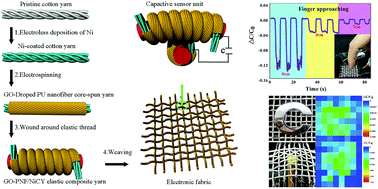Stretchable capacitive fabric electronic skin woven by electrospun nanofiber coated yarns for detecting tactile and multimodal mechanical stimuli†
Abstract
The development of highly sensitive, stretchable, and wearable textile-based electronic skin is of great value for application in human health monitoring, robot skin, and intelligent electronic devices. Here, we construct a highly sensitive and stretchable electronic fabric with a simple and low-cost electrospinning technology that enables us to simultaneously map and quantify the mechanical stresses induced by normal pressure, lateral strain, and flexion and to detect the noncontact finger proximity. The fabric is woven from composite yarns that are formed by a core-spun yarn wound helically around the surface of the elastic thread, wherein the core-spun yarn is obtained by coating a graphene (GO)-doped polyurethane (PU) nanofiber on the surface of a Ni-coated cotton yarn. The Ni-coated cotton yarn serves as conductive electrodes, and the nanofiber coating provides a dielectric layer. The three-dimensional elastic porous nanofiber structure of the dielectric layer, the fiber aggregate structure of the conductive electrode, and the helical structure of the elastic composite yarn play key roles in allowing the sensor unit of the electronic fabric to improve sensitivity, realize multiple-force sensitivities and realize stretchable and woven wearability. The sensor unit that can induce a large contact-area accumulation of the nanofiber dielectric layers under low external force exhibits excellent sensitivity (1.59 N−1, <0.3 N), a wide sensing range (0–5 N), a low detection limit (0.001 N), a short response time (<50 ms), good cycling stability and repeatability, as well as high strain sensitivity over a wide range (0–100%). In addition, we demonstrate that the electronic fabric is suitable for voice recognition, noncontact airflow monitoring, finger and wrist muscle movements, and noncontact proximity of fingers. This flexible, elastically woven textile-based sensor demonstrates potential applications in wearable electronic devices and humanoid robots due to its superior performance.



 Please wait while we load your content...
Please wait while we load your content...